
knife circa 1200
Short knife with broad and narrow blade, narrow fillet (fullering), wooden haft. c.1200. [Dordr.]. 5 in. long.

knife circa 1250-1300
Spear-point knife with engraved fillet on blade, whittle tang and plain wooden haft. c.1250-1300. [Dordr.] 7 1/4 in. long. wooden handle somewhat shrunken and warped.

razor blade 13th or 14th century
folding razor blade.

knife circa 1300
marked with (playing card) spade, partly-fullered blade and tang through a phallic-shaped wooden haft. From the Thames.

knife circa 1300
Heavy blade of tapering from with whitle tang. One piece wooden handle of tapering round section. tang peined over a washer at the end of the handle.

knife circa 1300
Tapered blade with narrow fuller at the rear edge of the face. Whittle tang. Brass disk bolster. Tapered wooden handle.

knife circa 1300
Slender knife, with wooden haft and pewter end cap. Note the latten fillet inlay along the blade. c.1300. [Thames]. 6 5/8 in. long. Some wood replaced by fill.

knife circa 1350
Knife with sunburst finialled latten haft (repaired at join to blade, also the blade tip - app. 1cm - is missing), c.1350 The blade has a triple mark - 2 crosses with a circle between. Marks at this date are extremely rare.

knife circa 1350
Whittle tang. One piece wooden handle. From Dordrecht.

knife circa 1350-1400
Short knife with spear point and twinned arrow point latten-inlaid mark, wooden haft. [Thames]. Ex. Coll. Simon Moore #1978.56

knife circa 1350-1400.
Shorter knife with rectangular wooden haft and marked with two multi-pointed stars. One is still mostly filled with pewter, the other has lost its fill. [Dordrecht]. 6 1/4 in. long.

knife circa 1380-1420
Iron blade with rounded point and straight edge. Maker's mark. Whittle tang. One piece wooden handle.
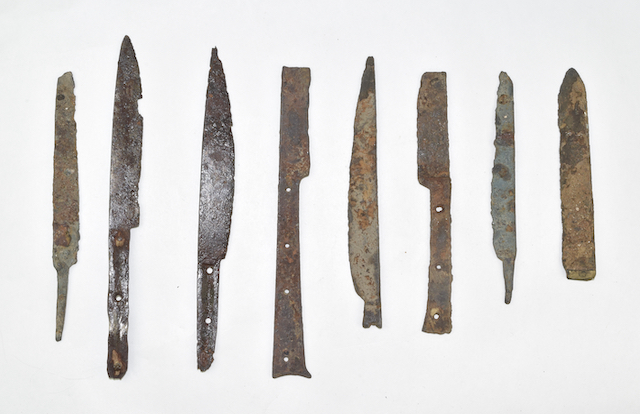
knife parts 14th-16th c.
Right 14-15th cent. retains the brass mounts used to terminate the handle scales.

knife 14th century
Bellied blade of good form. Iron bolster. Through whittle tang. Handle of single piece of wood, of oval form. During full re-photo-shoot in late 2019 I did not find this item. It may have been sold at some point.

knife 14th century
tin inlaid mark in the form of a cross. Clip point blade with whittle tang. Solid wooden handle. Small area of fill.

razor 14th-early 15th cent.
folding razor. All steel with a curled back tip. The handle is a simple folded piece of iron. The blade is attached by a single rivet. The blade still moves. Found at Dordrecht Holland.

scabbard 14th-16th c.
Scabbard. Leather with punched and linear decoration. Punched decoration on the main surface composed of diagonal lines of circles each with a short tail and groups of circles. Rear seam appears to have been an edge flesh seam. Conserved at the Museum of London. Extremely good condition.

sheath 14-16th c.
Tooled leather. decorated with a trefoil in a lozenge.

remains of a sheath 14-16th c.
Tooled leather. decorated with trefoils and diagonal bands.

sheath 14-16th c.
Tooled leather. decorated with a linear design.

knife circa 1400
Bone scales. blade with curved edge and straight back. Cutler's mark - 2 stars and a crescent.

knife circa 1400
marked with inverted copper alloy stem cup mark, fullered blade with full flat tang. Wooden scale haft. Bolster formed of two flat plates and with tang plate. From the Thames. 7 1/4 in.

knife circa 1400
two-handed sword mark, wooden scales and tang plate with washers, c.1400 From the Thames.

knife circa 1400
Whittle tang. One piece wooden handle. From Dordrecht.

knife circa 1400
Long, straight blade. Wooden handle formed of two scales secured by steel rivets. Cap formed of foil decorated with incised lines.

knife circa 1400
knife with hole in blade (not damage but sometimes these holes were plugged with soft base metal as decoration), wooden haft. [Thames]. 8 in. long.

knife circa 1400
Knife from Dordrecht Holland, marked with 4 tin-inlaid crosses. Blade with whittle tang extending through the handle, and secured through a small washer. Wooden one piece round section haft. Crack on one side of the handle, but generally in very good condition. Ex. Coll. Simon Moore #2001.48

knife circa 1400
Knife from Dordrecht Holland, crescent mark, plain iron bolster . dudgeon haft. During full re-photo-shoot in late 2019 I did not find this item. It may have been sold at some point.

knife circa 1400
knife from Dordrecht Holland, marked with a brass-inlaid halo, a nice hump-backed blade (like you see in mediaeval MSS), wooden scales with loop hole

Knife circa 1400
tapered blade with full through tang. Copper alloy finial piened to the end of the tang. Handle of two rootwood scales secured by three pin rivets and with one larger hole lined with a copper alloy tube. Two piece copper alloy applied bolster. Blade marked with a gothic r. Ex. Col. Simon Moore #99.26.

Knife circa 1400
bellied blade with straight back. Solid flat through tang with copper alloy edge. Handle of two wooden scales secured by solid iron pins.

knife circa 1420
small knife with copper-inlaid sickle mark, wooden scales with horned tang plate of copper alloy c.1420 From the Thames.

knife circa 1430
wooden handle. bolster and pommel of metal disks (tin and copper alloy) with wooden or horn infill. Some modern fill in the wood and between spacers (esp. in the bolster). Wookd with shrinkage.

knife circa 1430
Small knife from the Thames, marked with copper-inlaid lozenge, wooden scales and brass tang plate. Small iron applied bolster, one side remaining. 5 in. long.

knife circa 1430
Knife. ex. River Thames. worn trefoil mark, wooden scales. 5 loops and a curved tang plate.

knife circa 1450
Wooden scales attached by tubular brass rivets. The bolsters are brass. the handle is terminated by a horn end cap - between this and the wooden scales 2 thin brass plates remain. There would have been some organic (possibly leather) spacer between these two brass pieces, overall forming a very decorative end. Each scale is beveled - forming a hexagonal handle.

knife circa 1450
Slightly droppd point blade with full flat tang. Wood scales, 2 piece brass bolster formed from sheet secured by a single solid rivet, curved and notched brass end plate. Four tubular brass rivets. Blade marked with a cutlers mark. Ex. Col. Simon Moore #79.134. A slimilar knife is illustrated on page 78, top illustration, top knife in Cutlery For the Table.

knife circa 1450
Wooden scale handle attached by solid brass pins. Teardrop butplate with decorative terminal and bolset of brass. Bolster formed of a thin piece of shaped brass on each side of the blade.

knife circa 1450
Knife with latten flat plaque finial with crudely (very) engraved image. Two part applied copper alloy bolster. wooden scales. Ex. Col. Simon Moore #87.5

knife circa 1450
marked with crown and crescent, bellied blade, wooden haft of 2 scales attached by solid iron rivets, From Dordrecht.

knife circa 1450
Clip pointed blade with rounded edge. copper-marked double crescent. Two piece applied copper alloy bolster. dudgeon scale haft secured by three tubular rivets. Handle terminated by a large ring finial. From the Thames. Ex. Col. Simon Moore #89.17.

knife circa 1450
Fine knife marked with tin alloy device, wooden scales with circular pricking around rivets, tang plate. From the Thames.

knife circa 1450
Blade with full flat tang. ragged staff tin alloy-inlaid mark, square tip, bone and copper alloy finial with washer inserts. Wood handle of two scales. Secured by two small tubular rivets and with three large tubular inserts. From the Thames.

knife circa 1450
Narrow blade with full flat tang and deep narrow fuller on one side. Cutlers mark a circle with seven dots. Ebony scales secured by four tubular rivets. Iron pommel in the form of a pyramid. Remains of one sheet bolster.

knife circa 1450
Whittle tang. One piece wooden handle. From Dordrecht.

knife circa 1450
small clip point blade with wooden scale handle. brass rivets. brass bolster and pommel.

knife circa 1450-1500
Short belly-bladed knife with club wooden haft and pommel, pewter inlaid mark of an axe. From Dordrecht.

knife circa 1470
Fullered blade (on one side) Two part copper bolster of sheet with filed decoration. O cutlers mark. Handle formed of a single piece of wood - which has deteriorated.

knife circa 1480
Small knife with tapered, slightly dropped point blade with full through tang. Wooden scales and latten haft strip surrounding the wooden scales cleaned, but without repairs. latten haft strips are rare. These seem to be attached by soldering the edge strip to the edge of the tang. The wooden scales are recessed into the edge strip. The wood is now basically flush with the edge strip - this may not have been the case originally. Scales secured by 3 pins, two obviously copper alloy, one possibly iron. Ex. Col. Simon Moore #87.70

knife circa 1480
Wooden handle of two scales. Riveted to the tang of the knife with iron rivets. Pommel of animal form with a bill. Ex. Coll. Simon Moore #90.47

knife circa 1480
Short knife, from Dordrecht Holland. Marked but there is a crack on the mark, slope point, brassy handle pierced with hearts - poss. a child's knife. quite rare as such.
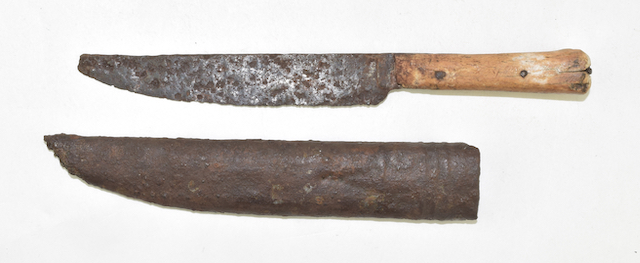
knife circa 1480
Knife. ex. Thames. Short knife with original iron sheath (dug together). Bone scales wiht bifid end (part of one scale missing). Marked on the reverse wih a device.

knife circa 1480
Knife. ex. Thames at Billingsgate in the late 1980s. Flat tang with bone scales attached by three tubular rivets. The handle is inlaid with additional decorative brass inlays. The inlays alternate - two round with pairs of engraved lines (possibly bells) and two trefoils. Brass bolster plates with roped front ridge and curving up to overlap the handle scales and trefoil pommel with a line of wiggle-work decoration on each side. Stabilized blade. Ex. Coll. John Homan. 18.3cm (7.3 inches)

Knife circa 1480
Blade with a full flat tang. Crown finial of two plates soldered to the end of the tang. Applied bolster of two plates. Wood scale handle secured by three tubular rivets down the center of the shaft and then decorated with a larger tubular rivet and two small ones forming a face. Marked with an indistinct copper alloy inlaid cutlers mark. Ex. Col. Simon Moore #1979.51.

Knife circa 1480
Long straight blade with short dropped point and full with through tang. Handle formed of two wooden scales. Final of two copper alloy plates. Engraved. Ex. Col. Simon Moore #99.29.

knife circa 1490
Knife from the Avon at Salisbury, marked with a saw, wooden scales in a brassy surround, pommelled. Very nice condition. Copper alloy portions retaining portions of original gilt. Simple applied copper alloy bolster, back and front strips and a crenelated and decorated pommel surmounted by a ball finial. Ex. Coll. Simon Moore (inv. #90.23). An elegant and delicate knife weighing 18.98 grams (292 grains or .669 ounces). Length including ball finial 7 7/16 inches (18.9 cm). The back of the blade is app. .085 in thick for much of the length of the blade, tapering to .050 where painted with the Simon Moore inventory number.

knife 15th century
knife handle of 2 wooden scales. Bolster formed of two of brass. Pommel formed of 2 flat pieces of brass. Bolster and pommel with engraved line decoration and remains of gilding. Scales affixed by solid brass rivets. Handle in remarkably good condition. Blade with (likely) significant losses.

Knife 15th c.
Blade with a full flat tang. Rounded end with back-bevel on three quarters of the blade. Marked with a copper alloy or possibly gold inlaid cutlers mark of an inverted goblet. Narrow bolster of very clean form, copper alloy of two plates. Handle formed of two wooden scales secured by small tubular rivets (some wood replaced with fill). Tri-lobed finial with engraved line decoration and with what appear to be two thin plates between the finial and the wood.

Knife 15th c.
slightly bellied blade with flat full tang. Scales almost all lost. One small piece remaining on each side secured by the central rivet. Copper alloy bolster of two plates secured by an iron rivet and copper alloy terminal with some simple decoration.

Knife terminals 15th and 16th c.
assorted knife pommels and terminals. Left and second left bottom of tapered rectangular form made from sheet and engraved. Center top three and center bottom two cast. Right two of sheet applied to the side of a full flat through tang.

knife circa 1500
Flemish/dutch type with rootwood scales forming the handle. Scales attached by 3 solid brass rivets with washers on each side. Brass bolster formed of two parts - uncharacteristically thick with a roped edge at the blade. Brass pommel in the form of a horse's hoof with a shoe. A nearly identical knife is part of the collection of the Victoria and Albert Museum in London - M.41-1954. It can be seen here : http://collections.vam.ac.uk/item/O111309/knife-unknown/#

knife circa 1500
Flemish style 'boot' pomelled knife. Blade with a drop point, whittle tang and with a crescent mark. Pommel of uneven hexagonal form with a flat end plate. Formed of sheet brass. Heavily engraved with images of saints and palms. Radiating engraved lines on the end plate. Bolster formed in one with the blade. Similar knives are shown on page 105, top image in Cutlery for the Table.

knife circa 1500
Knife with flat tang terminated by a dog head finial, wooden scales, three hollow latten rivets c, 1500

knife circa 1500
Knife with hexagonal latten finial, ebony scales, inlaid cutler's mark. Finial and scales with deep engraved lines parallel to the corners. Finial with three lines of wiggle work decoration. Scales secured by three rivets with large, flat, round heads. Applied latten bolster secured by one rivet. , c. 1500 (may have lost a bit of its tip)

knife circa 1500
Wooden handle of 2 scales. Iron pommel of horseshoe shape, forming a cap over the end of the handle. The handle is intaid with a rose patterned washer and is decorated with brass pins attaching the handle scales Two of these pins are arranged normally, then there is a group of three in front of the rose washer. Remains of one applied bolster. Marked with a fleur-de-lys cutlers mark.

knife circa 1500
Handle formed of bone scales. Flat through tang secured by small pins. Applied latten bolster formed of two scales.

knife circa 1500
leather worker's knife with broad beaked blade, bone haft cross-hatched and latten band. [Scheldt]. Ex. Coll. Simon Moore #2000.52.

knife circa 1500
drop -pointed blade with full through tang. Applied copper alloy bolster of two plates. Rootwood haft of two scales secured to the tang four tubular rivets. Atypically two of these are centered and two more are in a pair near the larger hole in the end of the handle. Larger decorative hole also filled with copper alloy ring. Terminal copper alloy washer in the form of a 4 petaled flower. Marked with a Lombardic L. Ex. Col. Simon Moore #88.14.

knife circa 1500
Knife from the Thames, unmarked, brass shoulders engraved AVE MA(RIA?) over both sides, wooden scales and brass surround (missing on lower surface of haft), flat terminal engraved with a woman's head on one side and a hawk on the other. The handle seems a little shorter than usual.

knife circa 1500
Knife from the Thames, marked with a crossed h, solid latten haft (heavy) and decorated with file work

knife circa 1500
Narrow knife from the Thames, marked twice with ??, iron bolster and bone scales decorated ring and dot, small wafered brass tang plate. 6 3/4 in. long. Ex. Col. Simon Moore #2000.23

knife circa 1500
Knife from the Thames, marked with Gothic capital V and quatrefoil, bone scales inlaid with engraved roundels and with twinned dog's head finial

knife circa 1500
Blade with fuller and bevel. Marked with a Gothic lower case 'd'. minimal brass bolster. Handle of 2 wooden scales.

Pricker circa 1500
Steel with integral bolster and finial. Wood scales on each side secured by iron pin. blade of square section. Ex. Col. Simon Moore #2000.30.

Knife circa 1500
Slightly tapering, clip point blad with flat through tang. bone scales.

knife circa 1500-30
Blade with drop point. Integral long bolster of rectangular form. through tang at 90 degrees from the blade. Horn handle with spot and circle decoration. Handle of 2 plates. One whole, the other missing the forward portion. Terminal plate lacking. Overall very good condition for the age.

knife circa 1510/20
Knife. ex. Thames. mark of 'S' attributed to Thomas Okys. Twist-carved scales - part missing on one side. Thomas Okys mark is shown as one of a set of recalcitrant London bladesmiths. See p. 126 of Simon Moore's book

knife circa 1520
Slender, elegant knife with wooden scales attached by tubular brass rivets.

knife circa 1520
Long carving knife. c. 1520. Blade hollow ground on both sides with integral iron bolster and flat through tang. Handle formed of bone scales. Scales attached with iron rivets.

knife circa 1520
slim knife with latten shoulders, wooden haft decorated with rivets and twisted latten finial. [Thames]. 10 in. long.

knife circa 1520
Belly Bladed and bolstered blade with whittle tang. Minimal (unrecognizable) maker's mark inlaid in copper. wooden haft (original, with some shrinkage and cracking - one crack re-glued) Part of the end of the handle missing.Minor corrosion to blade and small portion of the blade tip missing. 7.25in.

knife circa 1520
Straight blade with clip point and flat tang. Handle of two rounded scales continuing the line of the round finial and formed sheet metal bolster plates. Scales secured by three narrow pins. Finial decorated with an X in a rectangle on each side and lines radiating from the center on the end. unidentified makers mark.

knife circa 1520
Long slender knife showing most original shape (some losses to edge) and corrosion showing original 'grain' to metal. Marked with 2 hooked crosses. Whittle tang. Wooden haft. Brass bolster plates (one missing, other over cleaned) attached by large central rivet. Wooden handle decorated by 7 thin brass washers (more likely deep inlay since it is completely missing in areas of heavy cleaning). Handle cleaned to a smooth surface (affecting the shape noticeably). Boot cap terminal engraved with standing figures (some corrosion, but mostly visible). Terminal plate and a knop. Very little cleaning damage to terminal. Handle and terminal with flat back and curved sides with crease in the front (flat bottomed tear-drop shape). 8 1/2in.

Knife circa 1520
drop point blade leading to a straight back. Integral bolster. Solid flat through tang. Handle of two wooden scales secured by solid iron pins.

knife circa 1530
Tapered blade marked with a four petal flower. Handle formed of wooden scales secured by two solid rivets. Pommel of brass scales engraved. 'Flemish style'.

knife circa 1530
Knife with integral bolster and a horizontal strip tang. This is very similar to many early knives, but the tang is not in the plane of the blade - instead it is 90 degrees off. With halberd and chess piece marks, wooden scales. Scales secured by four iron pin rivets.

knife circa 1530
Whittle tang. Delicate separate bolster of copper alloy. One piece likely root wood wooden handle. Boot pommel of tear-drop cross section with engraving. Some linear shrinkage in the wood causing gaps to form. Ex. Col. Simon Moore #99.42

knife circa 1530
Blade with drop point and flat tang. bone scales secured by three rivets. Oval slightly rounded finial with a pair of engraved lines.

knife early 16th century
Blade with a blunt clipped point and integral iron bolster. Whittle tang. Iron end-cap. one-piece rectangular wooden handle.

knife circa 1530
Clip-pointed blade with small integral bolster. One obvious loss to the blade and surface corrosion, but overall complete. Marked with a Lombardic O. Wood scales (all original, only minor cleaning) attached by 3 central rivets in the half near the blade and 2 near the terminal. Terminal plate soldered to tang. 7.75in.

knife circa 1530
Short all-iron knife, from the Thames, marked with double crescent, with tiny trefid terminal. 5 1/4 in. long. Very similar knife illustrated at the bottom of page 110 in Cutlery For the Table.

Knife circa 1530
Small knife with slightly tapered blade with short dropped point. Full through tang. Crown finial. Copper alloy scales shaped with a longitudinal ridge which is intercepted at two spots on each side to expose ribs of stone or glass. Ex. Col. Simon Moore #2000.69. For two very similar knives see right two images in the left picture on page 106 of Cutlery For the Table.

knife circa 1550
Wood handle, integral iron bolster, whittle tang, laten spacers within the handle, laten end cap with decorative finial. Blade marked with a five pointed star cutlers mark. Remnants of gilt on blade. Ex. Col. Simon Moore #90.50

knife circa 1550
Long narrow blade with full through tang. bone scales, integral bolster and pommel. Scales secured by four pewter rivets. Ex Col. Simon Moore #93.51

knife circa 1550
Cut-down/ Byknife from the Thames, all iron and marked with letter R

Knives Part circa 1550
Short, drop point knife blade with integral oval bolster. Whittle tang retaining a set of metal washers that would have been separated by wood, bone or leather. Marked with two copper alloy inlaid marks. One of a lot of knives and a file. From the collection of Anthony De Reuck.

Knives Part mid 16th c.
Narrow blade with a small drop point. Long round integral bolster. Handle formed of two wooden scales. Writhen knot terminal of copper alloy. With A de Reuck tag identifying as being found by Maddon in 1979 from the Thames at ..... Marked with a cross. One of a lot of knives and a file. From the collection of Anthony De Reuck. Similar knives illustrated on page 116, top illustration in Cutlery For the Table.

knife circa 1570
All iron.Long blade and short handle with decorative terminal. 203mm.

knife Late 16th century.
Blade with integral tapered bolster and full flat through tang. Ebony scales. Pomel formed of a ring of brass with 2 engraved lines and a brass end plate. Ex. Col. Simon Moore #89.8

knife circa 1570
Small, all iron. round tapered handle with rounded end (slightly upset at the terminal). Medium corrosion. Blade possibly shortened slightly. Marked with a V. exc. Thames. 5 1/2in. Ex. Col. Simon Moore #1997.4

knife circa 1570
Tapered blade with tapered square bolster. Mark with 3 dots and some points (can't tell what it is, any ideas?). Ivory block haft of 2 pieces, the latter part engraved with rings and dots. Between the ivory sections and the ivory and the bolster thin brass washers (8 and 4) with modern resin in-fill.Some cracking in the ivory. Very minor corrosion on blade. Chip loss at one corner of the terminal. 6 1/4in.

knife circa 1570
Long, slender knife with integral iron handle. Handle of round form with a turned terminal. Marked. With A de Reuck tag identifying the mark, 16th or 17th c. date and that it was found by Barnes at the Little xxxx Dock on the Thames October 1978. One of a lot of knives and a file. From the collection of Anthony De Reuck. Specific dating based on similarity to K-18, dated by Simon Moore.

knife circa 1580
Maker's mark in the form of a halbard. Blade with integral bolster and whittle tang. Tapering faceted handle with inlaid brass circles near the pommel end.

knife circa 1580
Heavy blade (almost 1/4in. thick at the back) with bolster and thick tang. Wooden Handle scales - very thick (actually thicker than its width) attached with 4 hollow iron rivets (one missing). Some cleaning to the handle affecting its shape. Some resin fill between scales and tang, but minimal to replace losses/shrinkage. corrosion on blade is minimal (some pitting, edge losses and flaking, but mostly insignificant) 15.5 inches long, 365 grams. Simon Moore has only seen 3 of these on the market. Ex. Coll. Simon Moore #2001.21

knife 16th century.
Small knife with bone scales and a round pewter inset on one of the scales. 16th century. baluster and pommel formed in one piece with the blade. Solid tang. Scales riveted to the tang with solid iron rivets.Some cracking and fill on the handle scales, but overall in very nice condition.

knife 16th century.
Good integral iron bolster and attached pommel. Brass spacer between bolster and handle. Brass ovelays on the edges of the tang. Flaired iron finial. Wood scales most likely replaced. Cutler's double mark inlaid with copper alloy. Ex. Col. Simon Moore #94.49

Knives Part 16th c.
Knife blade with short drop point and large rectangular integral bolster. Whittle tang and retaining a small terminal. Marked with a copper alloy inlaid mark in the form of an H. One of a lot of knives and a file. From the collection of Anthony De Reuck.

Knife 16th c.
Tapered blade with integral oval bolster, flat full tang, and terminal. Scales missing.
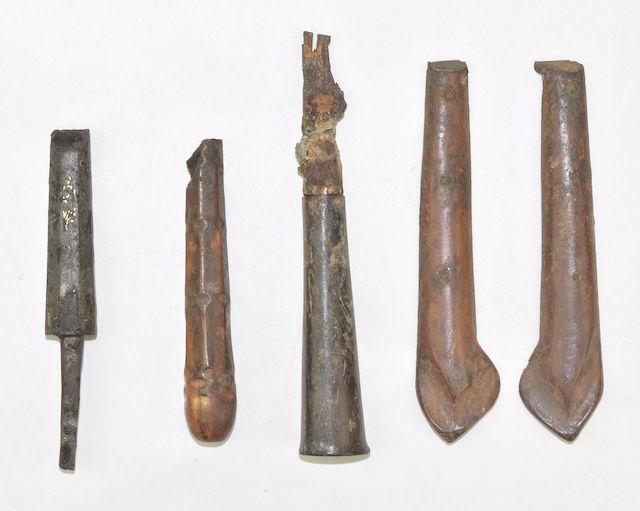
Knife handle elements 16th and 17th c.
assorted knife handles, handle scales and the bolster and tang from a knife.

knife circa 1600
Blade with drop point. Integral round bolster. Through tang with round horn scales. Attached by 5 thin iron pins. Marked with maker's mark in the form of diamond with a circle in the center with 3 circles forming a trefoil on one end and probably remains of same on the other end. Terminal plate lacking. Overall very good condition for the age.

knife circa 1600
Blade with drop point. Integral round bolster. Handle formed of 2 brass plates forming a hollow handle. Foliated decoration. Somewhat deformed.

Knife circa 1617
Knife with engraved blade with integral bolster. wood handle tapering and cut to facets. Engraving includes the date 1617. With A de Reuck tag identifying the location as Thames at Bull Warf by Pilson and Smith 2.7.1997. One of a lot of knives and a file. From the collection of Anthony De Reuck.
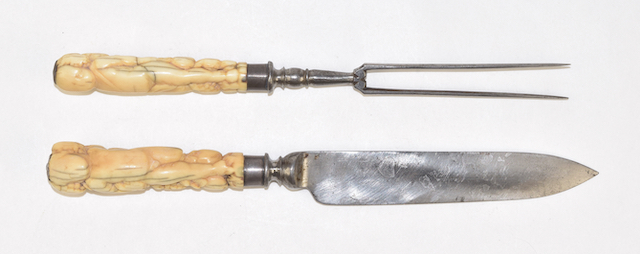
knife and fork circa 1670-1720
knife and fork. Carved bone or ivory handles in the form of naked figures on one side and garlands of fruit on the other. Very nice example, in good condition. Obvious original wear to the handles from original use.

Knife Steel 17th century.
formed in one piece with turned detail handle terminated by a writhen-knot finial.

fork 17th century.
Two tines with tapered stalk leading to a flaired bolster. Round bone handle.

knife 17th c.
Knife. ex. Thames. Bone handle. round. integral bolster. Triple mark - sword, crossbow and 'R'

knife 17th c.
Knife. ex. Thames. Bone handle. club. Large integral bolster. knife edge cut with teeth. These may be original, or they may be the result of early adaptation into a tool when it was out of style.

Knife 17th c.
slightly bellied blade with straight back. Solid octagonal pewter handle decorated with engraved longitudinal lines and stamped oval patterns on the main sides. Wrapped with central twisted wire band.
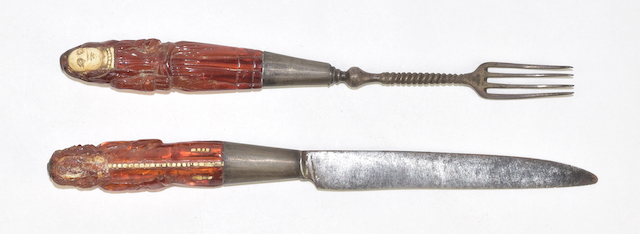
knife circa 1700
Knife and fork set. Holland. Not excavated. Steel knife blade and fork with integral bolsters and whittle tangs. Handles of amber with details in applied ivory or possibly bone. The handles form a pair of a man and a woman.
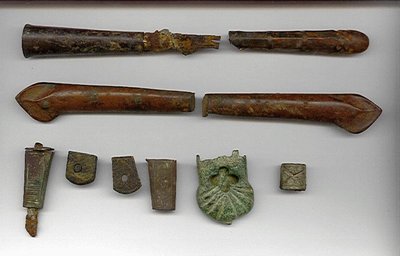
knife parts circa ??
Wooden handle of rouned section with remains of bolstered blade. Handle of hexagonal form with indented decoration. 2 scales from a wooden handle. Knife pommels and a scabbard tip.
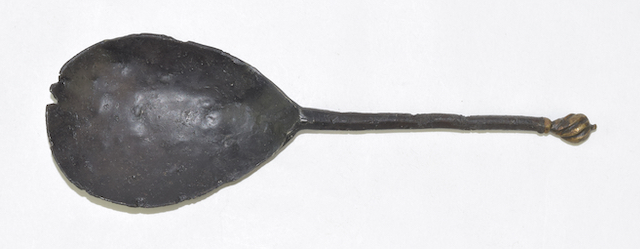
spoon circa c. 1400.
Spoon. body and handle of pewter with an attached latten 'writhen knot' terminal.

fork circa c. 1780.
fork. Iron with bone handle plates. Bone very sound, solid stable black oxide to iron body. Found in the River Thames.
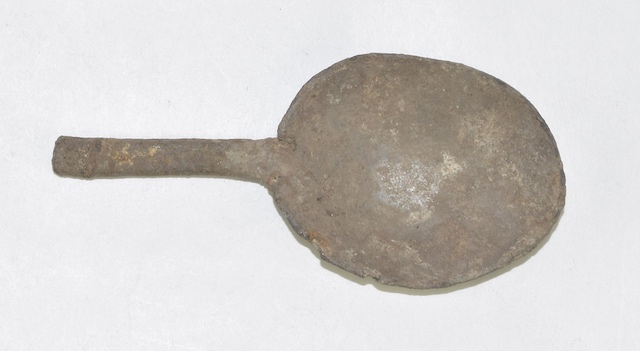
spoon circa c. ??.
Spoon. body and handle of pewter. Handle broken.

Knife Part Late 15th-mid 16th
Excavated. Remains of blade and handle. Roughly half of blade remains, with handle formed of copper alloy plates. flattened octagonal cross section tapering from the terminal to the bolster. plates attached to the tang with 3 rivets. Decorated with 2 sets of five filed lines. Small button terminal. Handle 3 /14 in. long, 2 3/8 in. of blade remains. See Allen Collection K-131 for a very similar, but complete knife.
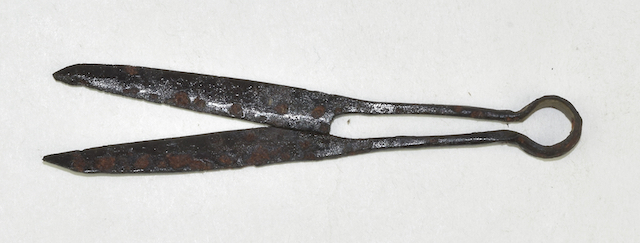
shears circa Medieval/Tudor
A pair of small iron shears from the River Thames. In a remarkable state of preservation, with only a few corrosion spots. These shears were used for light duty tasks such as cutting thread or trimming arrow flights. 93mm long. From the river Thames

File circa Tudor and later
Hand cut file of tapered, double edged beveled shape. One of a lot of knives and a file. From the collection of Anthony De Reuck.

Knives Part circa Tudor and later
Double edged blade with integral flat tang pierced with 3 holes. Sold as a spear head, but it seems more likely to be a specialty knife blade. One of a lot of knives and a file. From the collection of Anthony De Reuck.

Knife circa Tudor and later
Blade with a small drop point. Integral bolster. Handle formed of two wooden scales secured by five pin rivets. Handle and bolster forming a tapered oval. Flat terminal. With A de Reuck tag identifying as being found by ?epson in 1988 from the Vin??? Car Park, Marked with a cross. One of a lot of knives and a file. From the collection of Anthony De Reuck.